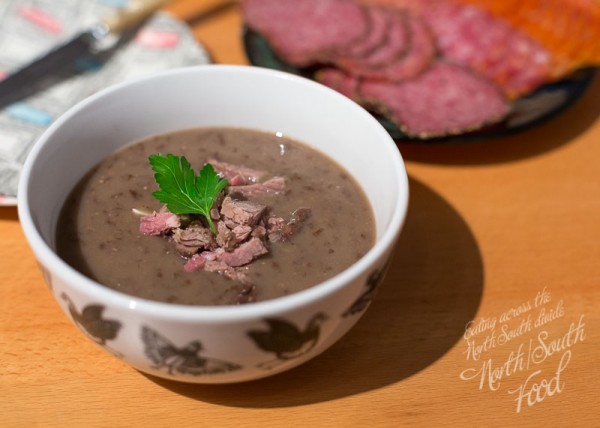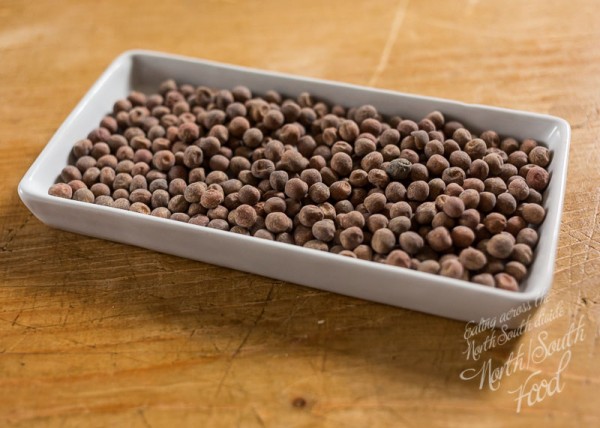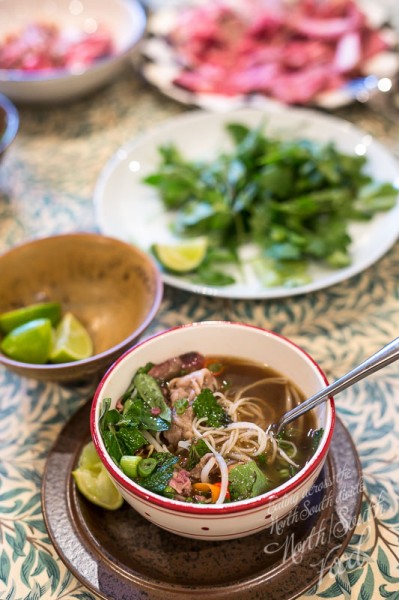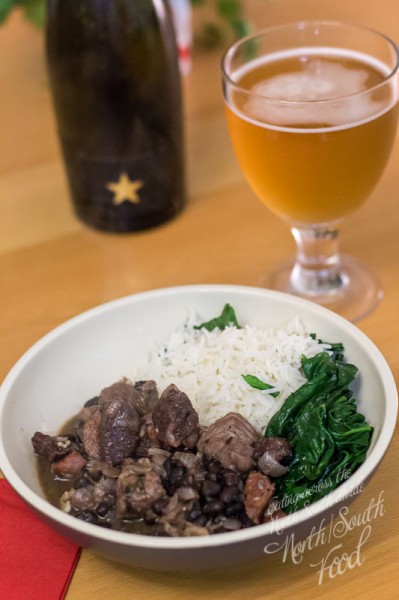
Happy New Year! Well, that’s Christmas over for another year. The tree’s gone, the decorations are down, and the last hints of spice in the air are fading fast. Miss South and I made the most of the season in our respective locations… both making Christmas puddings for the first time; cooking up a great main meal and seasonal accompaniments; and getting creative with leftovers. After all, getting good mileage from leftovers is one of the best things about the holiday season, isn’t it?
Here are two recipes for Christmas leftover soups, based on main dishes we’ve previously posted about over Christmas. Both have proved their worth (and have been road-tested with others) and provide a good way of taking your leftovers in a different direction. After all, If you’re going to splash out on a large cut of meat, make sure you make the most of everything around it… from boiling liquid to bones. You can’t beat a warming soup in winter: it’s the best form of central heating around, and a great way to make ingredients and flavours go a bit further. Whether it’s a thick, hearty black pea and spiced beef soup, or the exotic joys of a fragranced Vietnamese-style pho bo, you should find something to whet your appetite.
Black pea and spiced beef broth (serves 6-8)

Although it’s not based on a traditional recipe, this is a very northern dish in heritage and at heart. It’s got mixed Irish and Lancashire parentage, but I reckon a variation on this would feel equally at home in large swathes of Nordic or Eastern Europe too. It’d certainly keep the cold at bay. The spiced beef I used here followed our previously published recipe, which was based on Niamh Shields’. It’s established itself as a family tradition over the last three years!
We’re predisposed to pair pulses and pork on the blog as they’re natural BFFs, but here the sensuous spiced notes and savoury stock of the beef and its broth work really well with the dusky black peas* (not black-eyed peas).
Miss South and I first experienced black peas, parkin and cinder toffee on Bonfire night on a farm above Rochdale in the mid 1990s; that combination of frosty air and scaldingly-hot peas was a happy and formative memory for us both. When I moved to Manchester a few years later I visited Bury market and enjoyed the pleasures of a styrofoam cup of peas and black pudding on a winter morning (tip: you can fashion a spoon from a black pud link by biting the end off strategically).

*Black peas (aka maple or pigeon peas) are a bit of a rarity outside of East Lancs and the South Pennines, and I’m conscious many readers might not’ve heard of them before. They’re delicious, and deserve to be better known. They’re on sale just over the West Yorkshire border here in Todmorden around Bonfire Night, but you might struggle to get them out of season, never mind outside the region. Even most of my books on regional British specialities (Andrew Webb, David Mabey, Laura Mason & Catherine Brown etc) don’t mention them; and while Mark Hix does in ‘British Regional Food’, he mentions the Lancashire black or parched pea alongside a differently cooked Lenten ‘carling’ or ‘carlin’ from Tyneside and the North East. (if you want to know much more about black peas, I’d suggest this well-researched and comprehensive piece here).
Ingredients
- 1 fresh chilli
- 1 red onion
- 2 litres stock / liquid from boiling the spiced beef brisket
- 250g dried black peas (you can substitute with marrowfat or other dried peas, but the taste is quite different)
- 6 medium sized potatoes (I used Maris Pipers)
- (optional) salt and pepper to taste
- A sprinkle of finely sliced beef per person
- A dollop of sour cream
This recipe assumes you’ve cooked the spiced beef already. Ensure you retain all the liquid you’ve boiled the beef in: it should last, properly covered in a cool place, for a few days. You may want to strain it through a fine sieve or some muslin, as you’ll likely get some bits from the ground spices at the bottom of the pan.
Start the day before, by soaking the black peas in a large bowl, covered in water with plenty of room for them to swell up. Add a teaspoon of bicarbonate of soda to help soften them. Leave the peas to soak overnight. In the morning, rinse them well.
I had around 3 litres of stock from boiling up the spiced beef: I reduced this by a third so it was more intense. It was quite savoury; with the sugar, salt and spices really coming through strongly. I was concerned it’d be too strong, but those wee peas soak up liquid and flavour.
Cover the previously-drained peas with fresh cold water, bring to the boil and then boil hard for 10 minutes, before simmering for a further 30 minutes. Meanwhile sauté the finely chopped red onion and chilli slowly in a heavy-based pan, so it softens and starts to melt down.
Rather than continue to simmer the beans on the hob, I decided to make the soup itself in the slow cooker, but you could easily keep it in a pan. However making meltingly soft black peas is particularly good in the slow cooker as it’s self-contained and cheap as chips to run for hours. I left everything bubble for a few hours, then threw in the peeled, chopped potatoes for 30 minutes. Once they’d softened and cooked, I used a hand blender to process the soup, keeping it rough and textured rather than a smooth purée. Another 20 or so minutes just to soften everything down, and it’s ready to ladle into bowls.
Ideally serve with a dollop of soured cream, and sprinkle with chopped matchsticks of the leftover spiced beef on top. Garnish with some finely chopped chives or some flat-leaf parsley for a dash of colour.
Pho bo (generously serves 4)

My first taste of a decent pho was when Miss South took me to one of the Vietnamese places on the Kingsland Road in London about ten years ago. I’d heard it was one of the best breakfasts known to mankind, and I was smitten on the first slurp. I’ve been going to Vnam Café on Oldham Road in Manchester since it opened to get my hit in the north, but making your own is extremely satisfying, and a great way to get the most from beef bones. In fact this was so good we made it twice within the space of a fortnight last Christmas (as my girlfriend and I had two family Christmas meals; one in Manchester, the other in Belfast). Both times we used beef forerib which we’d roasted as a joint for the main meal. This is the kind of recipe which can certainly improve with specialist ingredients, such as Thai basil, but we didn’t adhere strictly to this prescribed recipe either time, and it tasted fantastic. I’d defy anyone to turn their nose up at this after a night on the tiles over the Christmas period. Just don’t plan a big lunch if you have it for breakfast…
It’s based on this recipe which I suggest you follow; I’ve added some personal notes below. I’ve enjoyed Andrea Nguyen’s Viet World Kitchen blog for years, but it was her recipe for pho which prompted me to finally buy her wonderful book ‘Into the Vietnamese Kitchen’, which I can highly recommend. Her additional tips on making pho are as useful as the main recipe. However there’s no set rule for making this soup, so feel free to substitute or ad lib if required.
Ingredients
For the broth
- Beef bones (in this case, from fore rib, but anything large and preferably with marrow is good)
- some nuggets of fat from the beef
- 300g brisket or similar beef cut
- 2 mid-size onions, halved
- 6-8cm ginger, sliced lengthways
- 5 star anise
- 6 cloves
- 1 cinnamon stick
- 4 tablespoons fish sauce
- 1.5 tablespoons rock salt
- 3 tablespoons rock or palm sugar
For the finished bowls
- Noodles (ideally flat rice sticks, but we used rice vermicelli first time, and something like dried ramen next)
- Fresh mint and coriander leaves, torn roughly
- Beansprouts
- Birds-eye chillies, sliced thinly
- Beef (we cut thin slices from the cooked rare rib meat, and poured the hot broth over)
- Scallions (spring onions), sliced and briefly blanched to take the edge off them
- Limes, cut into wedges
A key tip for the start; char your ginger and onions. Slice them, then hold them over the gas flame on your hob until they char nicely round the edges. This gives a lovely richness to the broth. Then add salt, spices, sugar, fish sauce, bones and the cut of braising beef to the pot. First time I made this, I used normal granulated sugar. Second time, at our mum’s, we used rock sugar…and it was so much better. Alternatively you could use some panela, or at least some sticky muscovado to give more depth and aroma to the sweetness in the broth.

First time, I used the slow cooker to make the broth overnight to allow all the flavours a chance to meld and mix wonderfully. Plus, the aroma you’ll wake up to is something else! At our mum’s we simmered the stock for several hours in the evening in a cast iron casserole, then let it cool overnight, before giving it some more time in the morning. This quicker cooking time was balanced out by being able to use more beef bones, giving a richer stock. However if you can, use the slow cooker for maximum flavour impact!
Strain the dark, delicious broth to remove any bits of spices and aromatics. You’re wanting to retain just the liquid. If you’ve used any braising cuts of meat in the stock you can retain it ready for a sandwich, shredded. Then put the broth back on the heat to keep warm.
The magic of pho for me is that tantalising counterplay between the slowly simmered, aromatic broth and the crispy fresh ingredients in the bowls. It’s bright and fresh, yet deep and complex. So ten minutes before you’re ready to serve, cook your noodles til al dente; then douse them in iced water to arrest their cooking further. Place them at the bottom of a deep, wide bowl; then add bean sprouts for crunch (I’ve also added mandolin’d carrot for brightness and bite). Add the meat, then pour over the hot broth. Let each diner garnish accordingly with fresh herbs, slices of chilli and scallion, and perhaps a squeeze of lime juice to taste. Happy slurping! Read more











